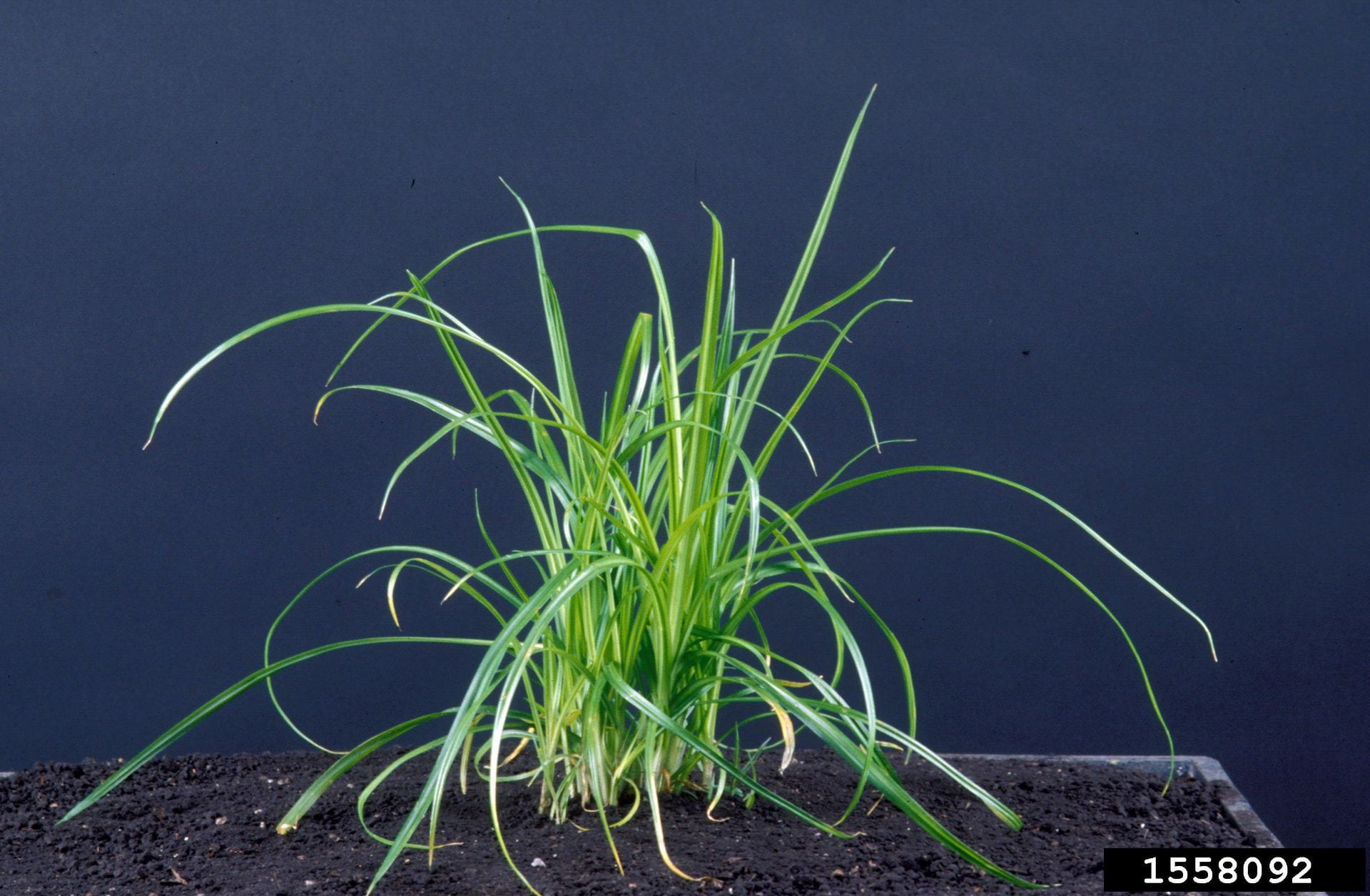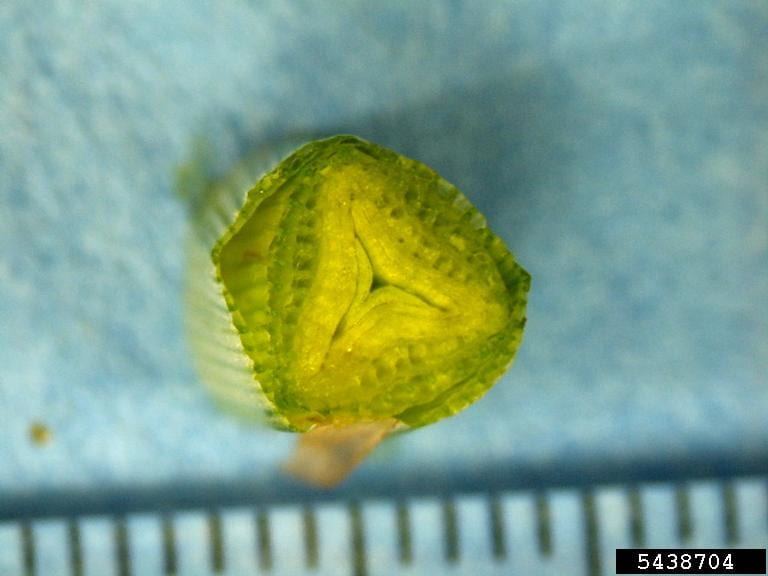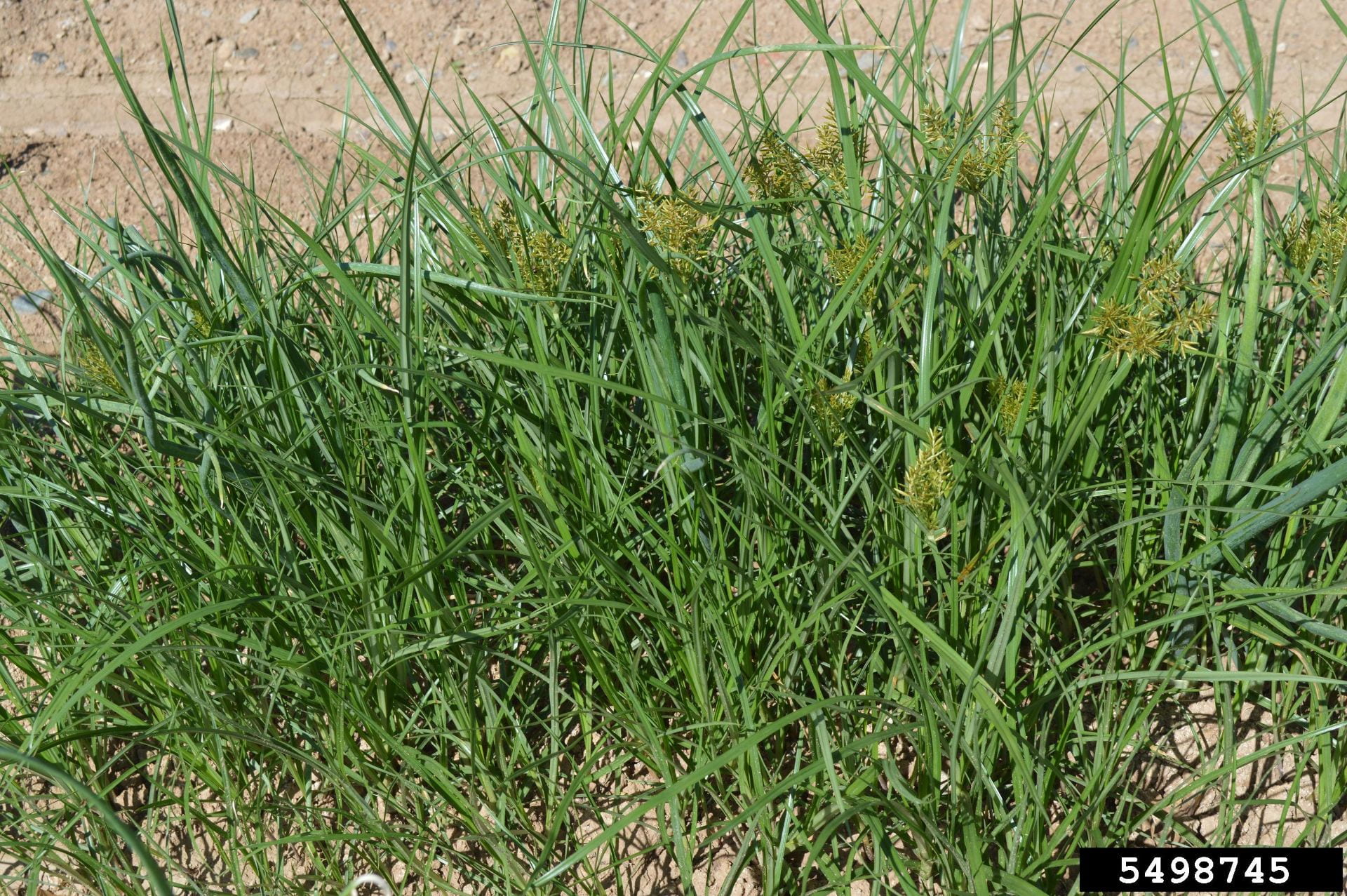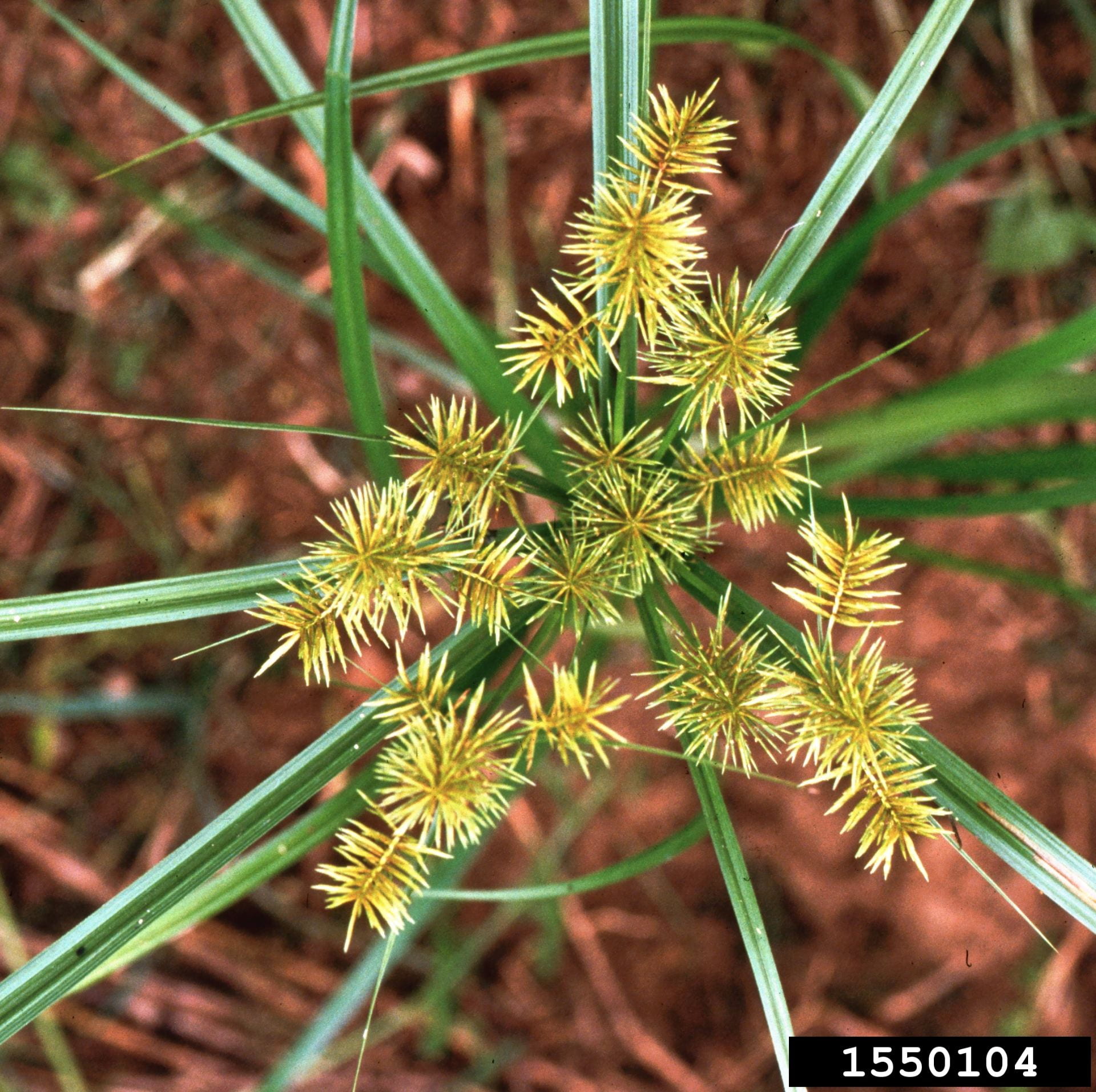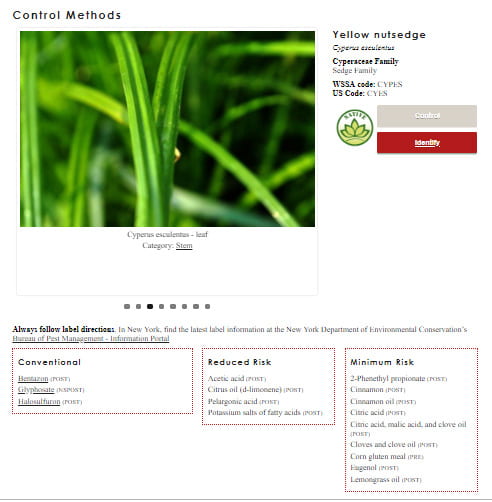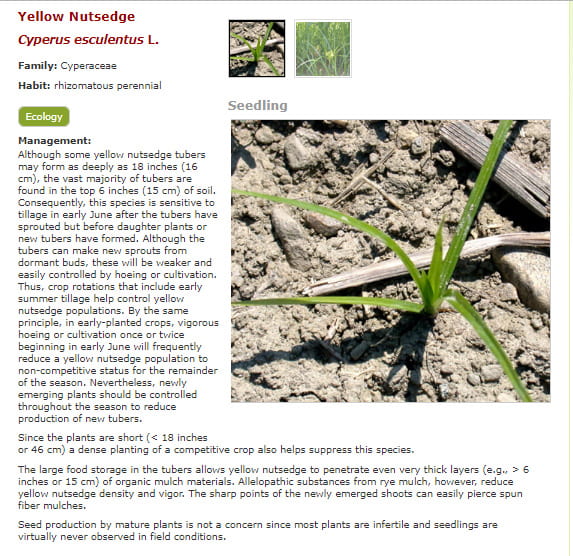Yellow nutsedge (Cyperus esculentus L.) is a weed of most agricultural, horticultural, and nursery crops as well as turfgrass and landscapes. It is found growing in many soil types and exposures, but is most common on well-drained, sandy soils or damp to wet sites. In NYS it is especially noted as a problem in vegetable, berries, and field crops. Infestations start in wet areas and then spread. Found throughout North America, yellow nutsedge is considered to be one of the world’s worst agricultural weeds; it is problematic in a wide range of crops, is not well controlled by some common herbicides, and is allelopathic.
Yellow nutsedge mainly reproduces via two kinds of underground nut-like tubers. One type germinates immediately, and the other overwinters. During the growing season, the plant produces underground structures called rhizomes, and a bulblet will germinate at the end of the rhizome to start a new plant to repeat the cycle. Towards the end of the season, overwintering tubers are produced. Over the course of a season, one plant can produce hundreds to thousands of tubers.
Yellow nutsedge plants. Photos from “Weed Identification, Biology and Management”, by Alan Watson and Antonio DiTommaso.
Yellow nutsedge infestation. Photos from “Weed Identification, Biology and Management”, by Alan Watson and Antonio DiTommaso.
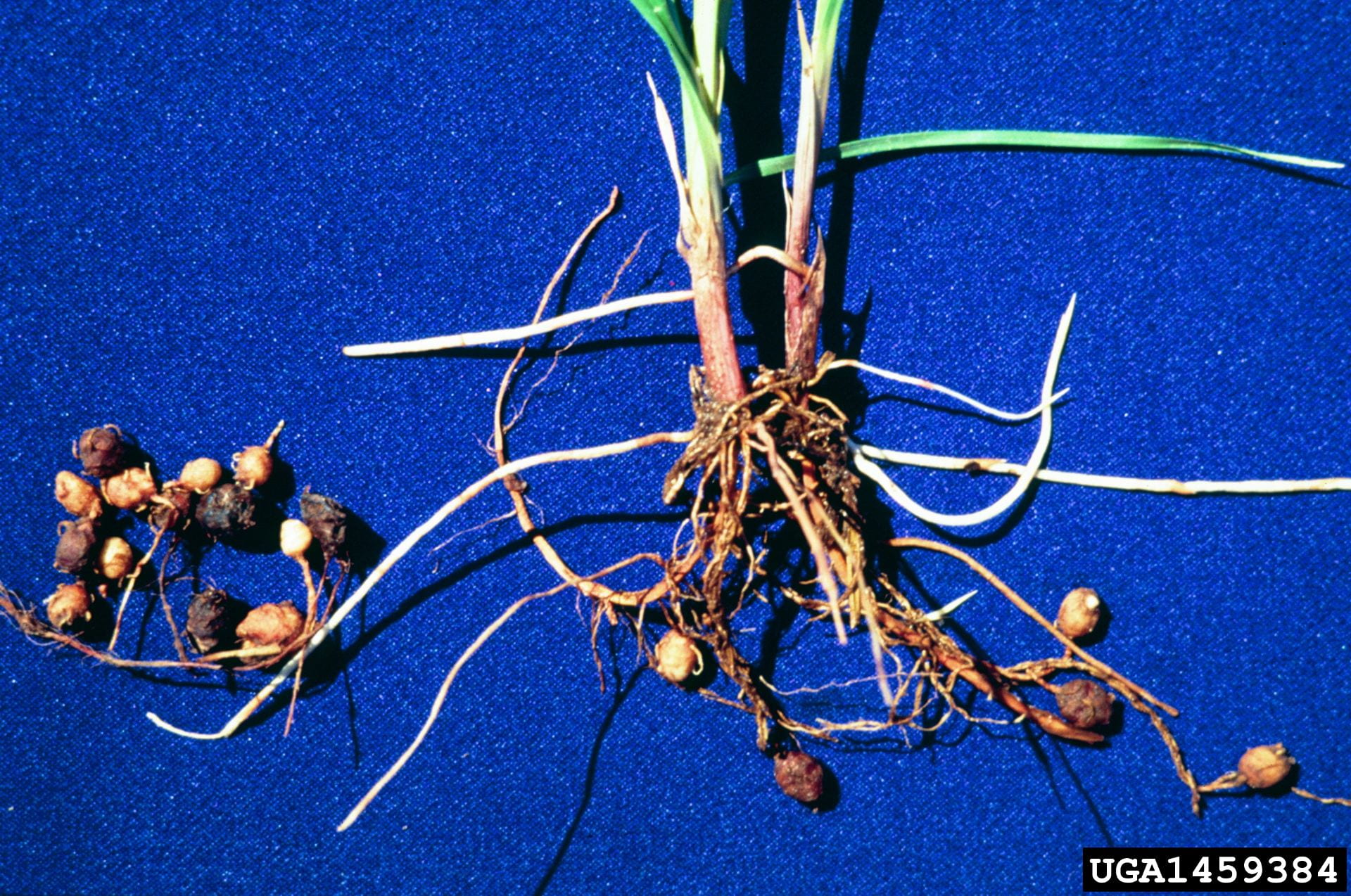
Yellow nutsedge roots, rhizomes, and tubers. Photo by Steve Dewey of Utah State University, via Bugwood.org.
Identification
Seedlings: Seedlings emerge in May, but are rarely seen as germination is low and the primary mode of reproduction for this plant is via tubers. They are grass-like, but have the triangular or three-sided growth habit that is characteristic of sedges. Plants sprouting from tubers also begin to emerge in May, but continue to sprout into July. These immediately produce yellow-green, V- cross section leaves in sets of 3, forming the characteristic triangular plant base.
Leaves: Leaves are flat and shiny or have parallel veins that form grooves and ridges. They are yellow-green, narrow (up to 8mm or 1/2″ wide) and grass-like. Leaves are produced at the base of the plant in groups of three, forming a sheath around the stem. Three much smaller leaves (bracts) grow on flowering stems, beneath the flowers.
Mature plant: Yellow nutsedge is distinctly yellowish-green and glossy, with stiff, grass-like leaves. Flowering stems are triangular, and leaves are v-shaped in cross section. Yellow nutsedge root systems have fibrous roots, thicker rhizomes, and small tubers (nutlike structures, 1-2 cm wide) at the end of rhizome segments. Flowering stems can be up to 1m (3 feet) tall; they are triangular in cross section, do not branch, and have no hairs. Flowers are held in spikelets at the ends of flowering stems.
Flowers/Fruit: Flowering occurs from July through September, with umbrella-shaped clusters of yellowish spikelets at the ends of flowering stems, each containing multiple inconspicuous flowers. Fruit are small, three-sided, and brown.
Management
As a perennial weed, yellow nutsedge may benefit when weed control programs selectively remove annual broadleaf and grassy weeds. Follow an integrated control program which combines growth suppression from tillage and herbicides along with shading from competitive crops. Pre and post planting applications can be made, as well as non-selective maintenance and spot treatments.
One report of herbicide resistance to ALS inhibitors (Group 2) reported in 2013 in the US, with rice grown in Arkansas.
Chemical control
Cornell University’s Turfgrass and Landscape Weed ID app offers suggestions for conventional and alternative chemical control options.
In apple orchards, nutsedge can be managed using summer sprays of glyphosate to prevent new tuber formation. Spring post-emergent herbicide sprays (halosulfuron-methyl, rimsulfuron) on young plants also help control nutsedge. See this article from Penn State for more information.
Use this tool to look up the efficacy of herbicides on a particular weed species. For general guidance on weed control, get the latest edition of the Cornell Crop and Pest Management Guidelines.
Non-chemical control
Cornell University’s Weed Ecology and Management website provides ecological control options for yellow nutsedge.
See A Grower’s Guide to Organic Apples from Cornell for non-chemical weed control options in apple orchards.
Climate Change and Management
Higher ozone concentrations increase tuber production in yellow nutsedge, making it a more difficult weed to manage. While ozone is most known as the protective gas in the stratosphere blocking harmful UV radiation, ozone in the lower troposphere can damage the health of people and affect plant growth. It is produced when air pollution from cars and power plants react on hot and still days, though these pollutants can travel hundreds of miles on the wind. As climate change increases the frequency of hot days we are likely to experience more high ozone days.
# of studies referenced in this section: 3
Similar species
Table 15: Shows yellow nutsedge (Cyperus esculentus) similarities and differences in identification compared to its similar species: purple nutsedge (Cyperus rotundus).
| Species | Yellow nutsedge (Cyperus esculentus) | Purple nutsedge (Cyperus rotundus) | ||
|---|---|---|---|---|
| Similarities | Perennial; grass-like (sedge because of three sided stem); forms tubers | (sedge because of three sided stem); forms tubers | ||
| Differences | Yellow-green blades; brownish/yellowish spikelets; tubers form at the tip | Dark green blades and stems; reddish-brown/purple spikelets; tubers form along the rhizome |
References
Uva R H, Neal J C, DiTomaso J M. 1997. Weeds of the Northeast. Book published by Cornell University, Ithaca NY. The go-to for weed ID in the Northeast; look for a new edition sometime in 2019.
Cornell University’s Weed Ecology and Management website. Contains a wealth of information on ecological management of agricultural and garden weeds. Look for a revamp of this site in 2020 or 2021.
Cornell University’s Turfgrass and Landscape Weed ID app. Identification and control options for weeds common to turf, agriculture, and gardens in New York; uses a very simple decision tree to identify your weed.
Purdue University (no date). Yellow Nutsedge Control. Extension publication. Detailed chemical management prescriptions, although they are for homeowners rather than farmers; New York’s pesticide laws differ from Indiana’s, so make sure the prescriptions are legal in New York. Authors: Aaron Patton and Dan Weisenberger.
Basedow, M and L Sosnoskie. 2020. Strategies for Dealing with Pesky Perennial Weeds. Article published in the April 2020 issue of Tree Fruit News. Covers control of yellow nutsedge, Canada thistle, field bindweed, and dandelion in apple orchards.
Crassweller, R. 2017. Orchard Weed Control – Nutsedge (Cyperus esculentus). Article on how to control nutsedge in apple orchards from Penn State Extension.
Peck, G M and I A Merwin. A Grower’s Guide to Organic Apples. Covers organic weed control methods for organic apple orchards.
Breth, D I and E Tee. 2016. Herbicide AI by Weed Species. This tool allows you to look up the efficacy of an herbicide active ingredient on a particular weed species.
Grantz, D.A. and Shrestha, A. (2006) ‘Tropospheric ozone and interspecific competition between Yellow Nutsedge and Pima Cotton’, Crop Science, 46(5), pp. 1879–1889. doi:10.2135/cropsci2005.06.0167.
Shrestha, A. and Grantz, D.A. (2005) ‘Ozone impacts on competition between tomato and Yellow Nutsedge: Above‐ and below‐ground effects’, Crop Science, 45(4), pp. 1587–1595. doi:10.2135/cropsci2004.0619.
Mary, J. (2020) ‘Weeds and their management under changing climate: A Review ’, Agricultural Reviews [Preprint], (Of). doi:10.18805/ag.r-2054.





